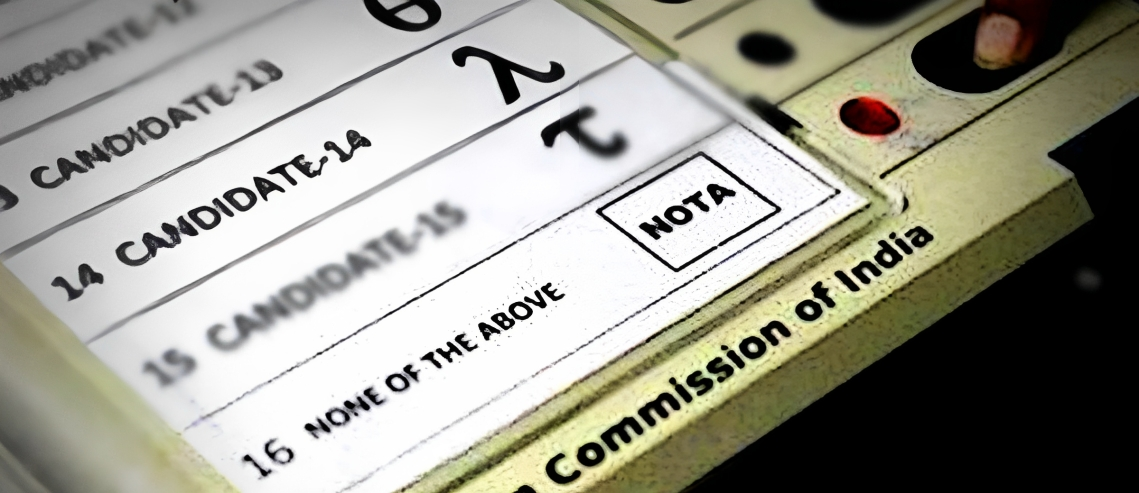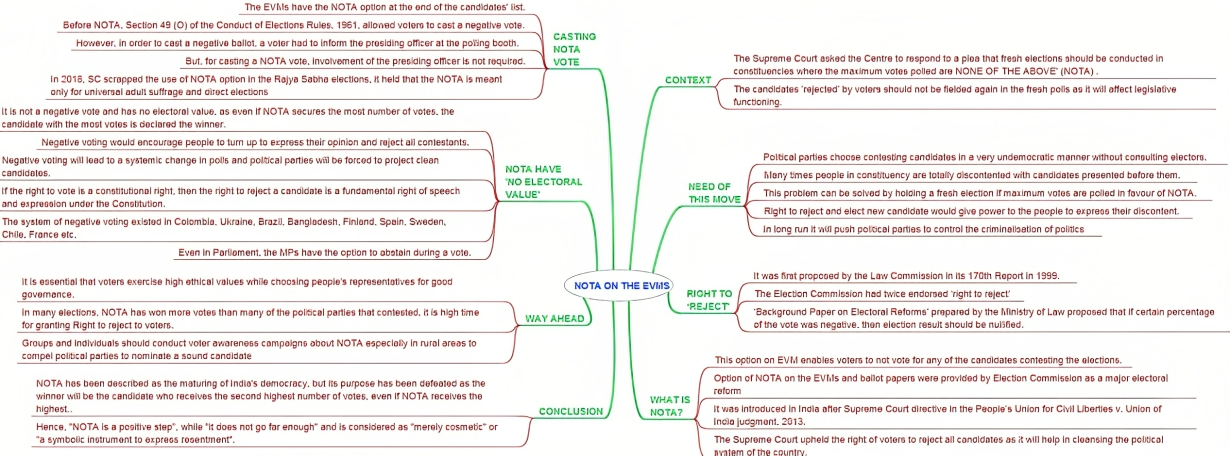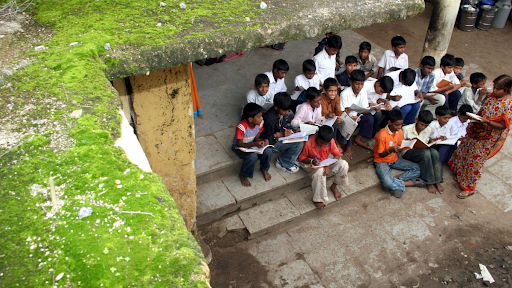Description

Copyright infringement not intended
Context: In the recently concluded Karnataka assembly election 2023, over 2.6 lakh voters chose to exercise their right to reject all the candidates by opting for the NOTA option on the electronic voting machines (EVMs).
Details
- According to the data released by the ECI, NOTA received more votes than 23 political parties and 555 independent candidates in the Karnataka assembly election.
None of the Above (NOTA)
- NOTA is a symbol introduced by the Election Commission of India (ECI) in 2013, following a Supreme Court order, to provide an option to voters who do not want to vote for any candidates.
- The ECI has clarified that NOTA votes are counted as invalid and do not affect the outcome of the election.
Objectives
- To enable electors who do not wish to vote for any of the candidates to exercise their right to reject without violation of the secrecy of their decision.
Some of the factors that may have influenced the voters to opt for NOTA are
- The prevalence of money and muscle power in the election campaign eroded the credibility and integrity of the candidates and parties.
- The lack of development and basic amenities in many constituencies, made the voters feel neglected and disillusioned.
- The dissatisfaction with the performance and policies of the incumbent government and the opposition parties, which failed to address the issues and aspirations of the people.
- The emergence of new parties and alliances created confusion and uncertainty among the voters.
- The influence of social media and civil society groups raised awareness and encouraged critical thinking among the voters.
Significance
- It would go a long way in cleansing the political system of the country.
- It would encourage people who are not satisfied with any of the candidates to turn up and express their opinion and reject all contestants.
- It would lead to a systemic change in polls and political parties would be forced to project clean candidates.
- If the right to vote is a statutory right, then the right to reject a candidate is a fundamental right of speech and expression under the Constitution.
- It is a symbol of protest and dissent against the political class that often fails to meet the expectations and aspirations of the people.
- It is a way of expressing dissatisfaction and disillusionment with the existing choices and demanding better alternatives.
- It is a way of holding the political parties accountable for their performance and conduct.
- It empowers the voters to reject candidates who are corrupt, criminal, communal or incompetent. It also gives a voice to those who are otherwise alienated or apathetic towards the electoral process.
Challenges
- Despite its symbolic and expressive value, NOTA has some limitations and challenges that need to be addressed.
.jpeg)
No Impact on the Electoral Result
- NOTA have no electoral value or consequence. Even if the maximum number of votes cast is for NOTA, the candidate getting the most of the remaining votes would be declared the winner. This means that NOTA does not invalidate or cancel an election, nor does it trigger a re-election or a run-off.
- It does not affect the outcome or result of an election in any way. It only records the number of voters who chose to reject all candidates.
Not reflect the mind of the voters
- NOTA does not differentiate between the reasons for rejection.
- It does not indicate whether the voters rejected all candidates because they were unhappy with their policies, ideologies, personalities, backgrounds or performance.
- It does not capture the nuances and diversity of opinions and preferences among the voters.
- It also does not provide any feedback or suggestion to the political parties or candidates on how to improve their appeal or credibility.
Lack of awareness and acceptance
- NOTA do not have much awareness or acceptance among the voters and political parties.
- Many voters are still unaware of the existence or meaning of NOTA, or how to use it on EVMs or ballot papers.
- Some voters may confuse it with invalid votes or abstention.
- Some political parties may dismiss it as irrelevant or insignificant, or even as a threat or challenge to their legitimacy or popularity.
- Some may also try to influence or manipulate the voters to not use NOTA or to vote for them instead.
Steps need to be taken
- To make NOTA more effective and meaningful, some possible reforms and measures can be suggested.
Legislature Support
- Give NOTA some electoral value or consequence, such as invalidating an election if NOTA gets more votes than any candidate or triggering re-election or a run-off if NOTA gets more than a certain percentage of votes.
- This would make NOTA more impactful and influential, and force the political parties and candidates to take it more seriously and address the concerns and grievances of the voters.
- Giving legal or constitutional status to NOTA and making it mandatory for parties to nominate fresh candidates if NOTA get more than 50% of the votes in a constituency.
Preferential voting system
- Introducing a proportional representation system instead of a first-past-the-post system, so that parties get seats in proportion to their vote share and voters have more options to choose from.
- This would allow voters to express their preferences more clearly and accurately and also indicate their reasons for rejection.
- It would also reduce the chances of wasted votes or strategic voting, and ensure that the winner has majority support or approval.
Increase awareness and education
- A third suggestion is to increase awareness and education among voters about NOTA, its significance, usage and implications. This can be done through various media platforms, campaigns, workshops, debates and discussions.
- Voters should be informed about their rights and responsibilities as citizens and encouraged to participate actively and responsibly in elections.
- They should also be made aware of the profiles and backgrounds of the candidate.
Others
- Strengthen intra-party democracy and transparency in candidate selection, so that parties field candidates who are competent, honest and representative of the people.
- Reforming the electoral system by introducing measures such as state funding of elections, regulation of political donations and expenditure, disclosure of assets and criminal records of candidates, etc.

Conclusion
- NOTA is a form of protest vote that expresses the discontent and frustration of the voters with the political system. It also serves as a wake-up call for the political parties and candidates to improve their performance and accountability. However, NOTA is not a solution to the problems faced by democracy. It is important for the voters to exercise their franchise wisely and responsibly, and to choose candidates who can represent their interests and aspirations effectively.
|
PRACTICE QUESTION
Q. The NOTA (none of the above) option in the Indian electoral system is a form of negative voting that allows voters to express their dissatisfaction with the candidates or parties. What is the significance of NOTA in the context of electoral reform? What are the main challenges and opportunities for implementing NOTA effectively? How can NOTA contribute to the improvement of democracy and governance in India?
|

https://www.hindustantimes.com/india-news/karnataka-assembly-polls-result-over-2-6-lakh-voters-opted-for-nota-101683983758579.html












